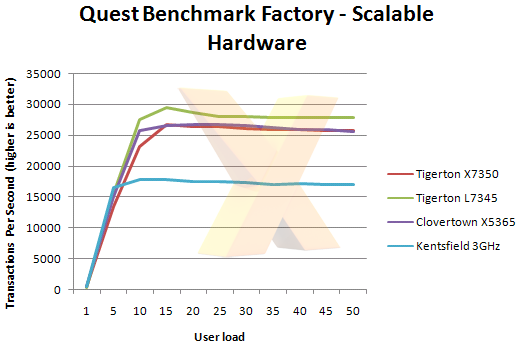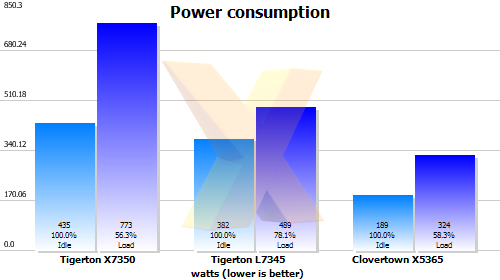Database performance and power consumption

Quest Benchmark Factory is a database testing suite that works in conjunction with an installed database server - in this case Microsoft SQL Server 2005. The Scalable Hardware test was chosen, with results from the CPU Intensive section being used for our analysis.
The first point that needs addressing is the Xeon X7350's performance - it's coming in slower than the L7345 despite a clock-speed advantage of over 1GHz.
We re-ran the test several times, with inconsistent results, until we discovered the root of the problem. For some unknown reason, the X7350 processors were running in a low-power state - their clock-speed reduced to just 1.6GHz.
This did not affect the L7345 as this part does not feature the Demand-Based switching of the X7350.
The Kentsfield and Clovertown systems are both CPU-limited, with Kentsfield reaching 100% CPU load at 10 users and Clovertown at 20. Kentsfield reached a peak of 17,858 transactions per second, while Clovertown achieved a maximum of 26,740 transactions.
In contrast, neither Tigerton reaches full CPU occupancy - even with the X7350 running at just 1.6GHz. The L7345 peaks at 29,453 transactions per second at 66% CPU load.
Without having a similar-spec AMD Opteron system to compare to, it's hard to tell whether this is indicative of software-scaling issues or is simply one aspect of the Caneland platform running out of puff.
Power consumption

Power consumption was measured from the wall socket, with consumption at idle power being judged when the system was left on the desktop with no programs running. Full-load figures were taken from the peak-power reading during a CINEBENCH R10 multi-threaded run.
Results for the Kentsfield were not included. While the overclocked Core 2 Quad Q6700 is representative of a Core 2 Extreme QX6850 in terms of performance, additional voltage was needed to ensure stable operation - and that resulted in higher than typical power consumption.
With the X7350 processors installed, the Caneland system pulls a massive 773W at full load. Changing to the L7345 parts drops over 280W from the system's full-load results - around 70W per processor, corresponding with a reduction in TDP from 130W to 50W. Of course, this isn't entirely unexpected given that the L7345 is slower by more than 1GHz.
What is somewhat unexpected is the X7350 using 53W more than the L7345 at idle. The L7345 idles at 1.86GHz, while the DBS of the X7350 allows it to drop down to just 1.6GHz - yet the X7350 still gives away 16W per processor.
The Clovertown, with its two 130W TDP processors, still manages to come in considerably lower than the Tigerton L7345 which it outpaces in some of our rendering tests. However, the large number of FB-DIMMs installed in the Caneland systems no doubt exacerbates the situation.
We would have tested with identical memory configurations but stickers on the memory risers warned of dire consequences that may occur if empty slots were not populated with thermal blankers. The reality is it would probably have been fine but we didn't fancy having to call Intel and explain we'd broken its £10,000+ server by ignoring a warning.









